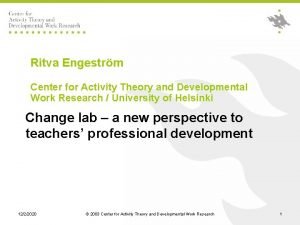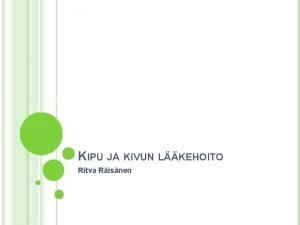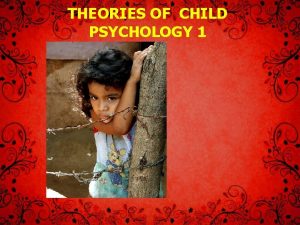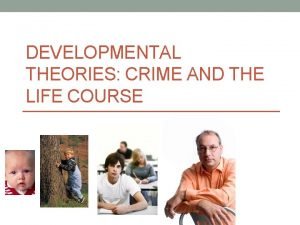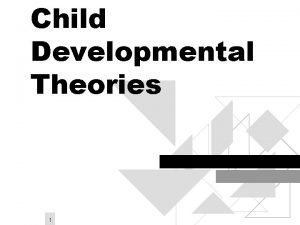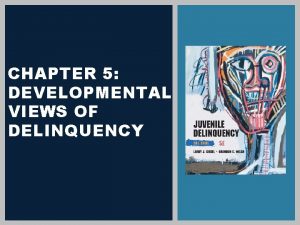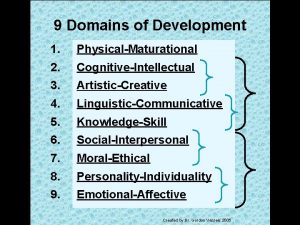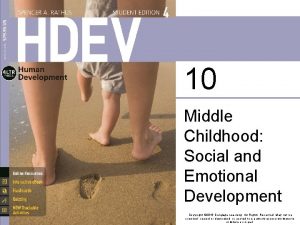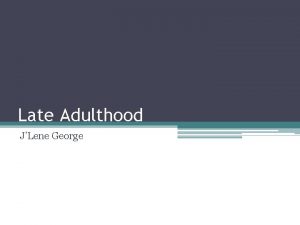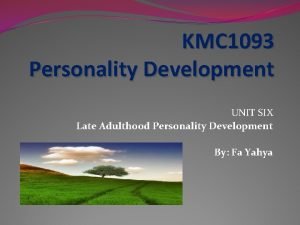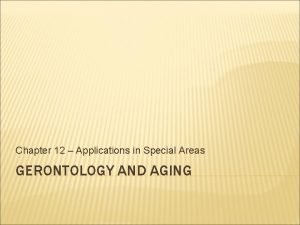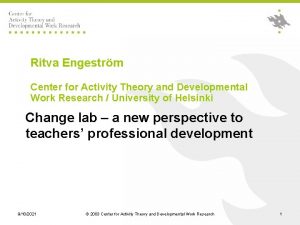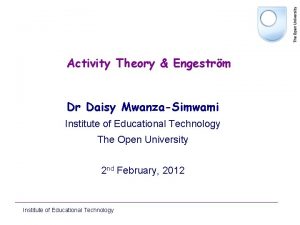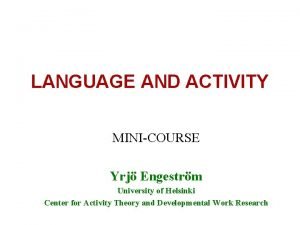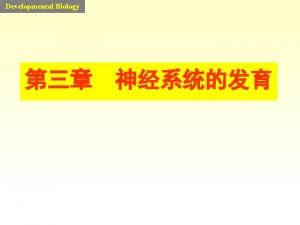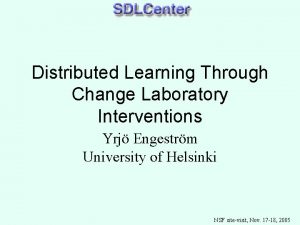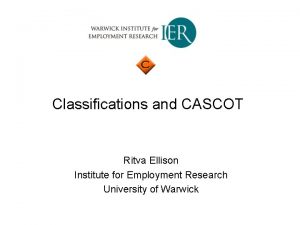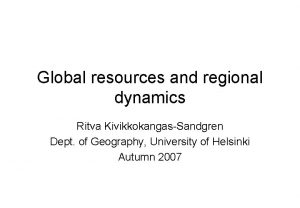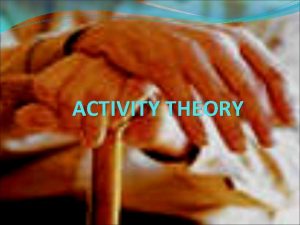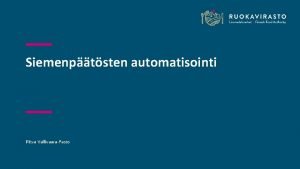Ritva Engestrm Center for Activity Theory and Developmental















- Slides: 15

Ritva Engeström Center for Activity Theory and Developmental Work Research / University of Helsinki Change lab – a new perspective to teachers’ professional development 12/2/2020 © 2003 Center for Activity Theory and Developmental Work Research 1

1. Theoretical framework is cultural-historical activity theory 2. Change laboratory method focuses on historically emerging tensions and contradictions in the activity system 3. The goal is to expand the understanding of practitioners’activity through experimenting and reflecting 4. Change laboratory is composed of polyphony and promotes people’s possibilities to utilize their multiple understandings and identities 12/2/2020 © 2003 Center for Activity Theory and Developmental Work Research 2

Zone of Proximal Development (ZOPED) The method of Double Stimulation (Reflexivity) Intervention method (Change Laboratory) q. HOW TO STUDY THE DIRECTION OF CHANGE AS ”NOT YET EXISTING”? q. HOW TO INTERCONNECT THE ORIENTATION TO THE ”NEW” WITH THE OPEN APPROACH TO THE FUTURE? q. WHAT ARE THE FUTURE-ORIENTED ACTIONS? 12/2/2020 © 2003 Center for Activity Theory and Developmental Work Research 3

EXPANSIVE LEARNING ZOPED FROM INDIVIDUAL TO COLLECTIVE CONTEXT 12/2/2020 © 2003 Center for Activity Theory and Developmental Work Research 4

Zone of Proximal Development: distance between present actions of the individuals and the historically new form of the societal activity that can be collectively generated as a solution to the double bind potentially embedded in everyday actions (Engeström , y. 1987, p. 174) 12/2/2020 © 2003 Center for Activity Theory and Developmental Work Research 5

The Cycle of expansive learning 7. Consolidating the new practice: 6. Reflecting on the process: 1. Questioning: 2. NEED STATE 2. Analysis: 5. Implementing the new model: 3. DOUBLE BIND CONSOLIDATION 4. Examining the new model: APPLICATION AND GENERALIZATION 12/2/2020 3. Modeling the new solution: FORMATION OF A NEW OBJECT © 2003 Center for Activity Theory and Developmental Work Research 6

The Change Laboratory setting New solutions, new model for practice Future Intermediate conceptual tools Present ”Mirror” of everyday practice (Historical and ongoing) Past Activity system framework 12/2/2020 Researchers Practitioners © 2003 Center for Activity Theory and Developmental Work Research 7

The change laboratory method in practice • Practitioners participate to the joint sessions with researchers • Participants gather data by videotyping and excerpts are shown in sessions (mirror data) • Participants work for change experiments • Sessions are videotaped for getting excerpts for reflection 12/2/2020 © 2003 Center for Activity Theory and Developmental Work Research 8

THE SCHOOL • • Secondary school (7, 8, 9, + 10 grades) 280 students 30 full-time teachers 30% of the students coming from immigrant families • Change Laboratory school year 1998/99 • Knowledge Laboratory 2000/01 • Knowledge Laboratory 2001/02 12/2/2020 © 2003 Center for Activity Theory and Developmental Work Research 9

12/2/2020 © 2003 Center for Activity Theory and Developmental Work Research 10

The activity system Instruments: tools and signs Object sense, Subject Rules meaning Community Outcome Division of labor Source: Engeström, Y. (1987). Learning by expanding: An activity-theoretical approach to developmental research. Helsinki: Orienta-Konsultit. (available online at: http: //lchc. ucsd. edu/MCA/Paper/Engestrom/expanding/toc. htm) 12/2/2020 © 2003 Center for Activity Theory and Developmental Work Research 11

12/2/2020 © 2003 Center for Activity Theory and Developmental Work Research 12

Activity System of teacher’s work Instruments: Textbooks, ICT Object: Knowledge acquisition Subject: Teacher Outcome: What are the capabilities of a citizen? Rules: Timetables curriculum 12/2/2020 Community: Division of labor: School, district, Between teachers unions © 2003 Center for Activity Theory and Developmental Work Research 13

Developmental Tansfer • Boundary Zone • Negotiations on a developmental project • The student’s role INTEGRATING • Schooling of teachers • Organizational development • Academic research • Professional development of teachers 12/2/2020 © 2003 Center for Activity Theory and Developmental Work Research 14

Two interacting activity systems Instruments Potentially shared object Instruments Subject Rules Subject Community Division of labor Community Rules Source: Engeström, Y. (2001). Expansive learning at work: Toward an activity-theoretical reconceptualization. Journal of Education and Work, 14, p. 136. 12/2/2020 © 2003 Center for Activity Theory and Developmental Work Research 15
 Kipu systems
Kipu systems Ritva räisänen
Ritva räisänen Theories of child psychology
Theories of child psychology Developmental theories
Developmental theories Skinner developmental theory
Skinner developmental theory Developmental theory juvenile delinquency
Developmental theory juvenile delinquency Havighurst theory
Havighurst theory Developmental theory
Developmental theory Despair vs integrity
Despair vs integrity Continuity theory vs activity theory
Continuity theory vs activity theory Continuity theory vs activity theory
Continuity theory vs activity theory Debye huckel limiting law
Debye huckel limiting law Kontinuitetshantering i praktiken
Kontinuitetshantering i praktiken Typiska drag för en novell
Typiska drag för en novell Nationell inriktning för artificiell intelligens
Nationell inriktning för artificiell intelligens Ekologiskt fotavtryck
Ekologiskt fotavtryck
